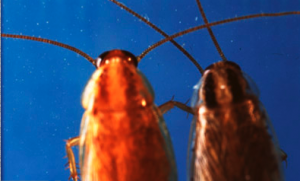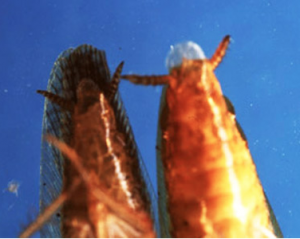Back to: Roach Articles
Asian Cockroaches
Kingdom Animalia
Phylum Arthropoda
Class Insecta
Order Blattodea
Family Ectobiidae
Genus Blattella
Species B.asahinai
The Asian cockroach is another member of the roach family that is fast becoming a major pest throughout the southernUnited States. This roach thrives in tropical and subtropical climates, and was first discovered in Tampa, Florida, in 1986. Early control methods and general knowledge of this pest were slow in coming, due in large part to the under-estimation of this insect. Florida residents were inundated with this flying roach that seemed to break all conventional wisdom of roach habits at that time, and professional exterminators had little answers. Since its discovery in Central Florida, this roach has spread across the Southeast to Texas, and as far north as South Carolina.
The Asian roach is truly omnivorous, eating plant material, as well as meats. At least one known benefit of the roach is that it readily feeds on certain crop pest eggs, and is a common predator of the Bollworm.
Asian roaches are most prominent during the summer months, and survive the colder temperatures mostly by burrowing into deep leaf litter. Even in warmer times, it’s not uncommon to find thousands of Asian roaches in all stages of life in a moderate-sized pile of leaves. It takes approximately 67 days for nymphs to reach adulthood, and females can produce egg capsules that carry up to 44 babies.
How They Travel
Unlike the German roach, the Asian roach is a very skilled flyer, and actually attracted to lights. The Asian roach prefers to live outdoors, but will survive inside for a time if the humidity is right or there is a source of moisture. Able to fly in open doors or crawl through small cracks or unfit screens, this roach often invades at night attracted by porch lights or lights from inside. Nymphs do not fly, but prefer to stay in organic litter, feeding presumably on the decaying matter.
How Best to Identify Asian Roaches
Gradual/incomplete metamorphosis the Asian roach is very similar to the German roach and is often confused for it. Chemicalanalysis by gas chromatography will confirm the species. However, there are also slight morphological differences between Blattella asahinai and Blattella germanica. Asian cockroach adults have longer and narrower wings than those of German cockroaches.The Asian roach dilemma is that it looks almost exactly like the German cockroach, but shares very little of the same behaviors. The Asian roach is light brown to tan in color, and has two dark brown longitudinal stripes on its pronotum (the back of its head). As stated, Asian roaches are adept flyers, while their German counter part can at best flutter if launching from a high perch. The Asian roach possesses longer wings that extend past its abdomen, whereas the German roach’s wings are either
Chemicalanalysis by gas chromatography will confirm the species. However, there are also slight morphological differences between Blattella asahinai and Blattella germanica. Asian cockroach adults have longer and narrower wings than those of German cockroaches.The Asian roach dilemma is that it looks almost exactly like the German cockroach, but shares very little of the same behaviors. The Asian roach is light brown to tan in color, and has two dark brown longitudinal stripes on its pronotum (the back of its head). As stated, Asian roaches are adept flyers, while their German counter part can at best flutter if launching from a high perch. The Asian roach possesses longer wings that extend past its abdomen, whereas the German roach’s wings are either  even or only slightly longer (the longer wing is believed to be why the Asian can fly so well, while the German cannot). Observing a gravid female, one can easily distinguish the Asian roach from German. The Asian roach wing will cover half or more of the extended ootheca (egg case), while the German roach’s will be almost completely visible. The surest way, however, is to examine the roach by turning it upside down, and noting the length of the wings. Past the tip of the abdomen is Asian, even or just passed is German.
even or only slightly longer (the longer wing is believed to be why the Asian can fly so well, while the German cannot). Observing a gravid female, one can easily distinguish the Asian roach from German. The Asian roach wing will cover half or more of the extended ootheca (egg case), while the German roach’s will be almost completely visible. The surest way, however, is to examine the roach by turning it upside down, and noting the length of the wings. Past the tip of the abdomen is Asian, even or just passed is German.
Treatment and Elimination
Inside, conventional indoor treatments work well for the Asian roach, with an emphasis around windows and doors where this pest will most likely first enter. The Asian roach does not thrive inside, so a full-scale treatment with dusts, baits, and sprays (as you may need for German roaches) is not always as necessary. Simple liquid residuals in cracks and crevices will do for interior infestations. Exterior treatments and/or modifications are far more likely to produce the best results for Asian roach reduction, and if possible, elimination. Liquid insecticide barriers around lights, windows, doors, and other entry points like hose spigots, the base of siding, cracks, or other voids work well, but are often short lived. Concentrates, such as Demand CS, Suspend SC, and Tempo, are excellent choices for these areas, but please read the labels for any limitations and safety recommendations.
Dusts are a longer-term answer for voids where this pest may enter, such as those listed above. DE (diatomaceous earth), Boric acid, DeltaDust or Drione are all long-term options for voids, but DeltaDust is specifically formulated to withstand the most moisture and may be the best choice. Proper equipment is needed such as a bulb, bellow, or puff duster to avoid off-target application, and complete treatment of voids.
Insecticidal granules and baits work very well, and can be applied as a broad barrier around the home, or areas away from the structure where this pest is known to be. Talstar PL is a sand-based contact granule that can be lightly applied, and gives great results. Baits often work better, since this insect is a frequent flier and ground contact isn’t assured. Also, the granule does not always penetrate heavy leaf or organic litter. The best places to apply the baits are on leaf piles where this pest is heavily concentrated. Niban or other scatter baits are an excellent choice for Asian roach control.
Probably the quickest route to eliminating the Asian roach is to eliminate the organic material they inhabit. Removal of leaf piles, or burning provides very fast results. Changing outdoor lighting to yellow bulbs is also helpful to deter them, but is not quite as effective for the Asian roach as it is for other insects.
